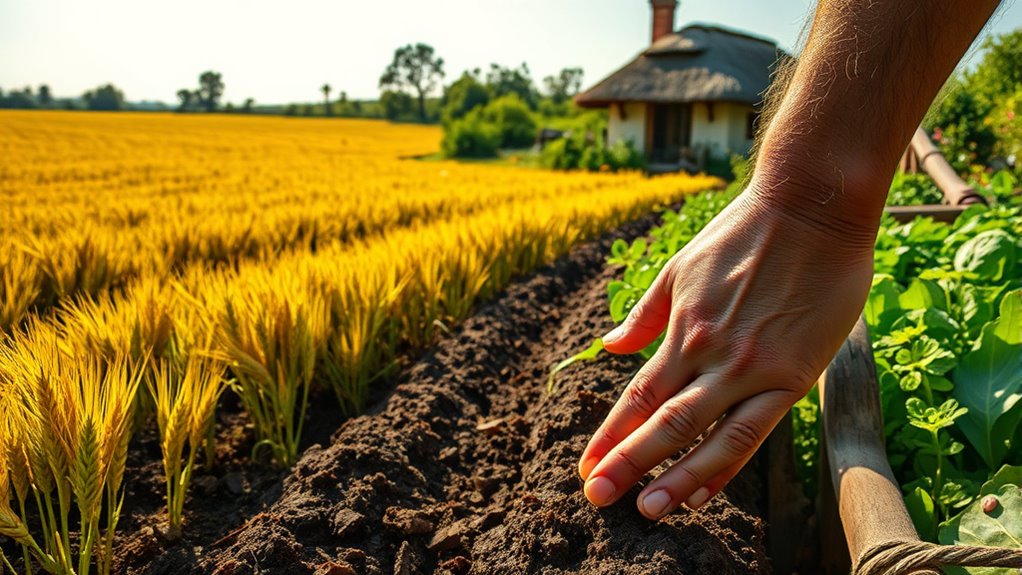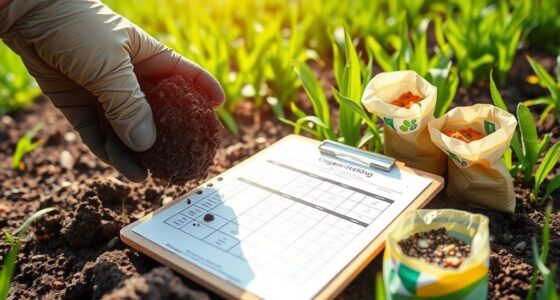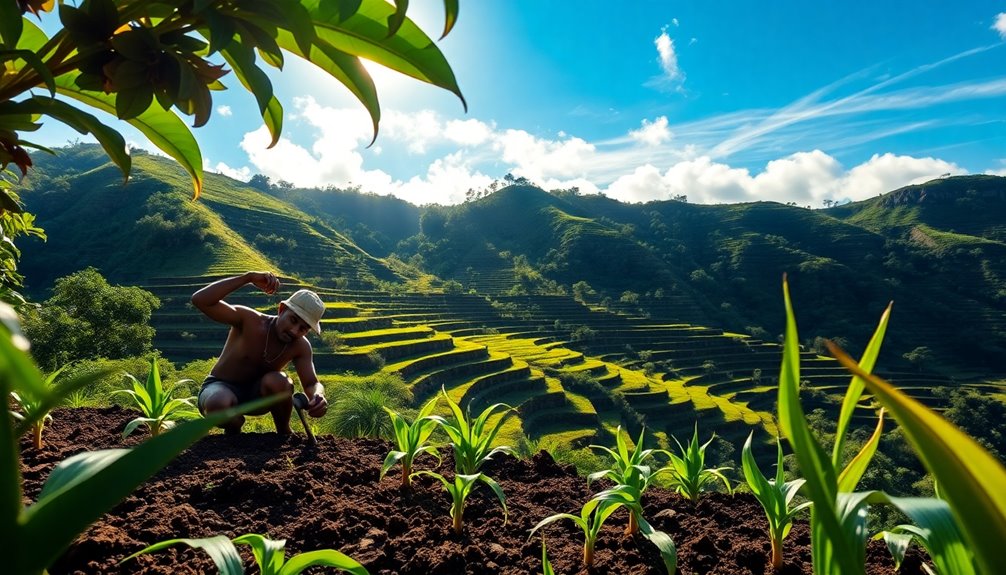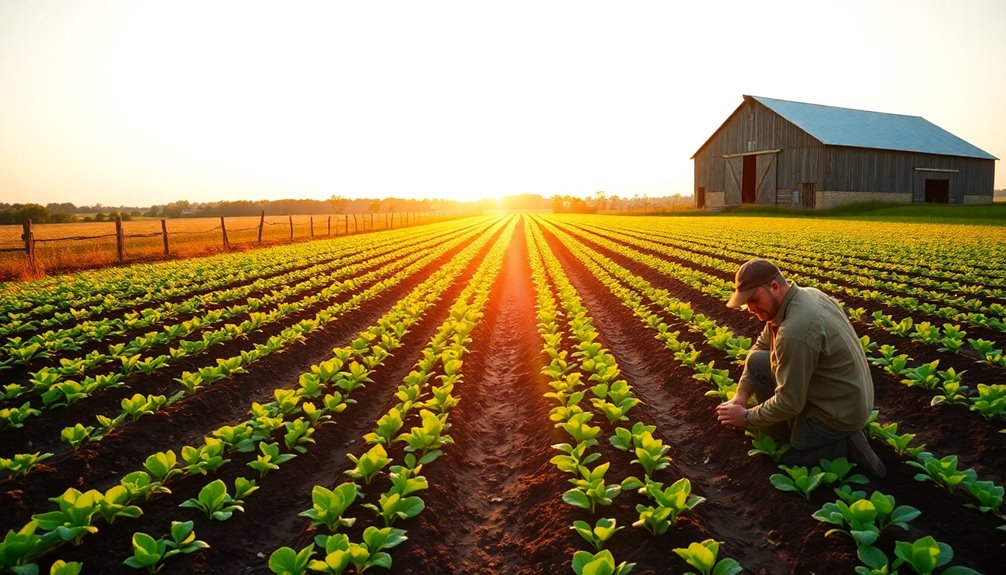Subsistence farming means growing enough food to meet your family's needs without relying on market sales. It focuses on small-scale operations, usually on plots under two hectares, where you use simple tools and rely on natural resources. This practice helps ensure food security and promotes a self-sufficient lifestyle, especially in developing countries. You'll also discover how it impacts the environment and communities, making it an important agricultural approach worldwide.
Key Takeaways
- Subsistence farming prioritizes small-scale agricultural production primarily for family consumption rather than for market sales.
- It includes various types, such as shifting cultivation, intensive subsistence farming, and nomadic herding, each with unique practices.
- This farming approach relies on simple tools and traditional practices, emphasizing family labor and minimal technology use.
- Subsistence farming promotes environmental sustainability by preserving biodiversity and utilizing natural resources responsibly.
- Economically, it supports rural livelihoods but faces challenges like limited market access and vulnerability to climate change.
Definition and Purpose of Subsistence Farming

Subsistence farming is a vital agricultural practice where families grow crops and raise livestock mainly for their own consumption rather than for selling in markets.
This small-scale farming, often on plots less than two hectares, plays a crucial role in developing countries with limited access to modern agricultural inputs. Its primary purpose is to ensure food security for your household, allowing you to maintain a self-sufficient lifestyle.
Types of Subsistence Farming

While exploring the different types of subsistence farming, you'll find several methods tailored to specific environmental and cultural contexts.
Shifting cultivation allows you to clear land, grow crops for a few years, and then move on when nutrients deplete.
Primitive farming relies on basic technology and small-scale cultivation near your home.
Intensive subsistence farming requires more manual labor, producing for a larger community with simple tools.
Nomadic herding involves moving livestock to various grazing areas, while terrace farming carves steps into hillsides for efficient land use.
Other practices include slash-and-burn agriculture in tropical regions and polyculture, where you grow multiple crops together for better biodiversity.
Each method reflects the unique challenges and opportunities of its environment.
Characteristics of Subsistence Farming
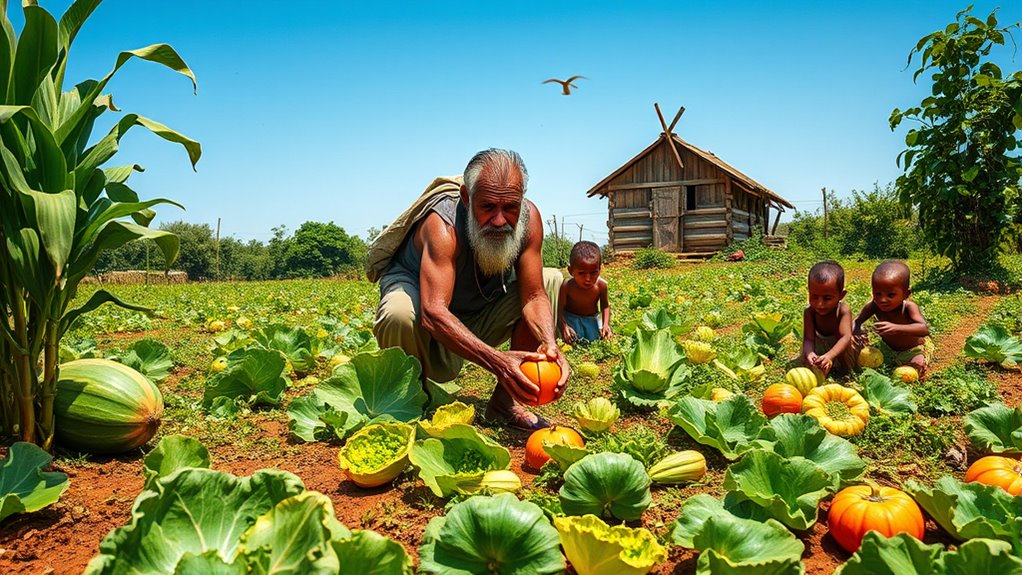
At its core, subsistence farming revolves around small-scale production that directly meets the needs of farming families.
You'll find that farmers typically use limited technology, relying on simple tools like hoes and machetes. They depend on natural resources, such as rainwater and fertile soil, to grow a diverse array of crops, ensuring nutritional variety.
Family labor is central, as relatives often provide the necessary workforce without the need for substantial capital investment. While there's limited market involvement, farmers may trade goods within their communities.
Family labor plays a crucial role, enabling farmers to cultivate their land with minimal investment while fostering community trade.
Traditional agricultural practices, like mixed cropping and crop rotation, help maintain soil health. This approach not only fosters self-sufficiency but also preserves cultural traditions tied to the land.
Environmental Impact of Subsistence Farming
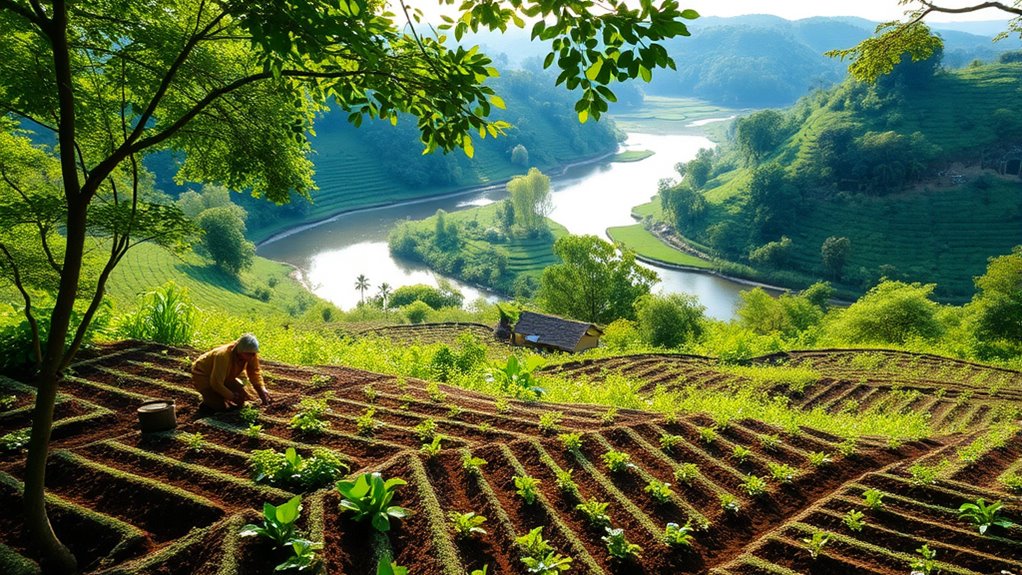
Although many might associate farming primarily with industrial practices, the environmental impact of subsistence farming is significant and multifaceted. By promoting biodiversity, you help preserve genetic diversity through diverse crops and animal breeds. Small-scale operations often use fewer chemicals, leading to healthier ecosystems.
Traditional knowledge guides sustainable practices like agroforestry and crop rotation, enhancing soil health and water quality. However, there's a risk of land degradation from overuse, particularly on marginal lands. Rain-fed agriculture can be unpredictable, impacting your yield.
While pollution from chemical use is limited, improper practices can still harm soil and water. Ultimately, your choices in subsistence farming contribute to ecological balance and long-term sustainability.
Economic and Social Aspects of Subsistence Farming

Subsistence farming plays a crucial role in the economic and social dynamics of rural communities, as it directly impacts livelihoods and cultural identity.
You might notice that these farmers face significant economic challenges, like limited access to markets and low capital for technology, which hinder productivity. Vulnerability to economic shocks and climate change can threaten food security, making their situation precarious.
Socially, family labor is essential, often highlighting traditional gender roles where women contribute substantially. While subsistence farming fosters community ties and cultural significance, the lack of education and skills limits the adoption of modern techniques.
Family labor in subsistence farming highlights traditional gender roles, emphasizing women's vital contributions while limiting the adoption of modern techniques.
Ultimately, this farming style provides basic food security but can struggle against broader economic pressures and limited income opportunities.
Global Prevalence of Subsistence Farming
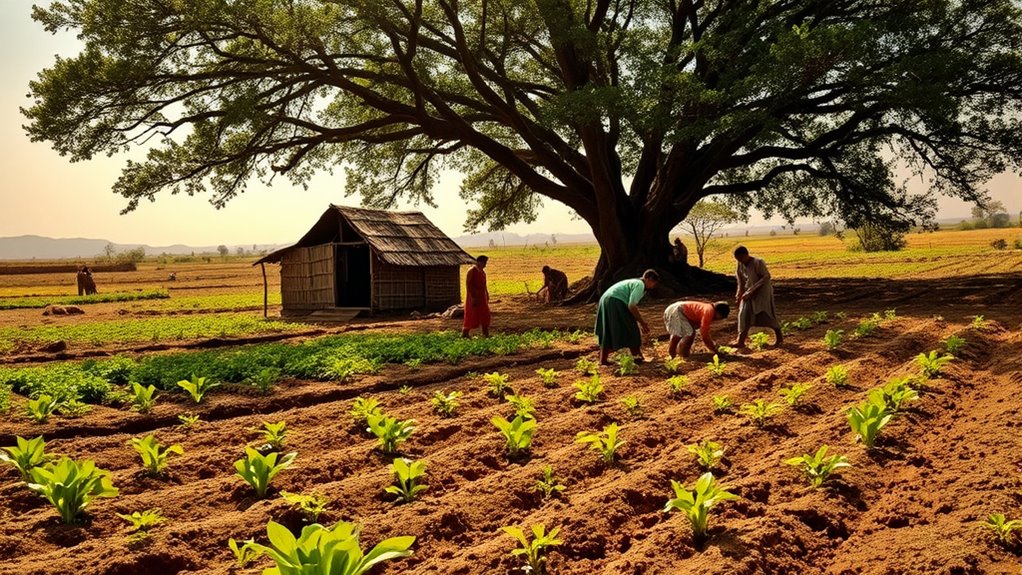
Around 2 billion people worldwide depend on subsistence farming, making it a vital source of livelihood in many developing countries. This practice is most prevalent in rural areas of Africa, Asia, and Latin America.
In China, nearly 98% of farmers work on small farms, while in India, about 80% are smallholders. Ethiopia and parts of Asia see nearly 90% of farmers engaged in subsistence farming.
Despite urbanization and industrialization leading to a decline in some regions, many communities continue these practices due to cultural ties and economic needs.
Subsistence farming not only supports food security but also promotes sustainable agriculture, emphasizing long-term soil health and diverse food sources, ensuring its importance for the future.
Frequently Asked Questions
How Does Subsistence Farming Differ From Commercial Farming?
Subsistence farming differs from commercial farming mainly in its purpose and scale. In subsistence farming, you focus on growing enough food to meet your family's immediate needs, while commercial farming aims to generate profit and meet market demands.
You'll likely cultivate diverse crops and livestock, whereas commercial farms specialize in specific products. Additionally, subsistence farming relies on traditional methods, while commercial operations use advanced technology to boost yield and efficiency.
What Challenges Do Subsistence Farmers Face Today?
As the saying goes, "You can't make an omelet without breaking a few eggs."
Subsistence farmers face numerous challenges today, including climate change, soil degradation, and water scarcity. These issues hinder your crop yields and overall productivity.
Economic constraints like limited access to credit and market fluctuations add to the struggle. Additionally, social factors and lack of government support can trap you in a cycle of poverty, making it hard to improve your situation.
Can Subsistence Farming Be Sustainable Long-Term?
Yes, subsistence farming can be sustainable long-term if you focus on practices that enhance soil health, promote biodiversity, and manage water wisely.
By using organic methods and crop rotation, you can maintain soil fertility and reduce environmental impact. Engaging with local communities helps build resilience and food security.
However, you'll need to address challenges like limited resources and climate vulnerability to ensure these farming practices remain viable for future generations.
How Does Climate Change Affect Subsistence Farming Practices?
Climate change significantly affects your subsistence farming practices. Rising temperatures and erratic weather patterns disrupt your crop yields and planting schedules.
You might face reduced water availability due to changing precipitation, leading to droughts or floods. This can threaten your food security and household income.
Adapting through crop diversification or traditional methods becomes essential, but financial constraints and limited resources often hinder your ability to implement these strategies effectively.
What Support Exists for Subsistence Farmers in Developing Countries?
In developing countries, you'll find various support mechanisms for subsistence farmers.
Governments often provide subsidies and training to enhance farming practices. International organizations offer research and technical assistance, while community-based projects focus on improving access to markets.
Microfinance programs help you obtain capital, and technological advancements, like digital tools and precision farming, can boost your yields.
Additionally, sustainable practices are promoted to ensure environmental conservation and resilience against climate change.
Conclusion
In essence, subsistence farming is more than just a way to grow food; it's a lifeline for many communities worldwide. By understanding its various types and impacts, you can appreciate how these practices shape both local economies and ecosystems. So, the next time you bite into a meal, remember that many hands, often working hard just to get by, contribute to that plate. It's clear that subsistence farming plays a crucial role in our global tapestry.

